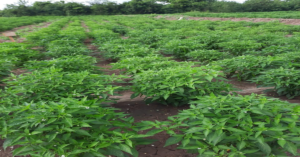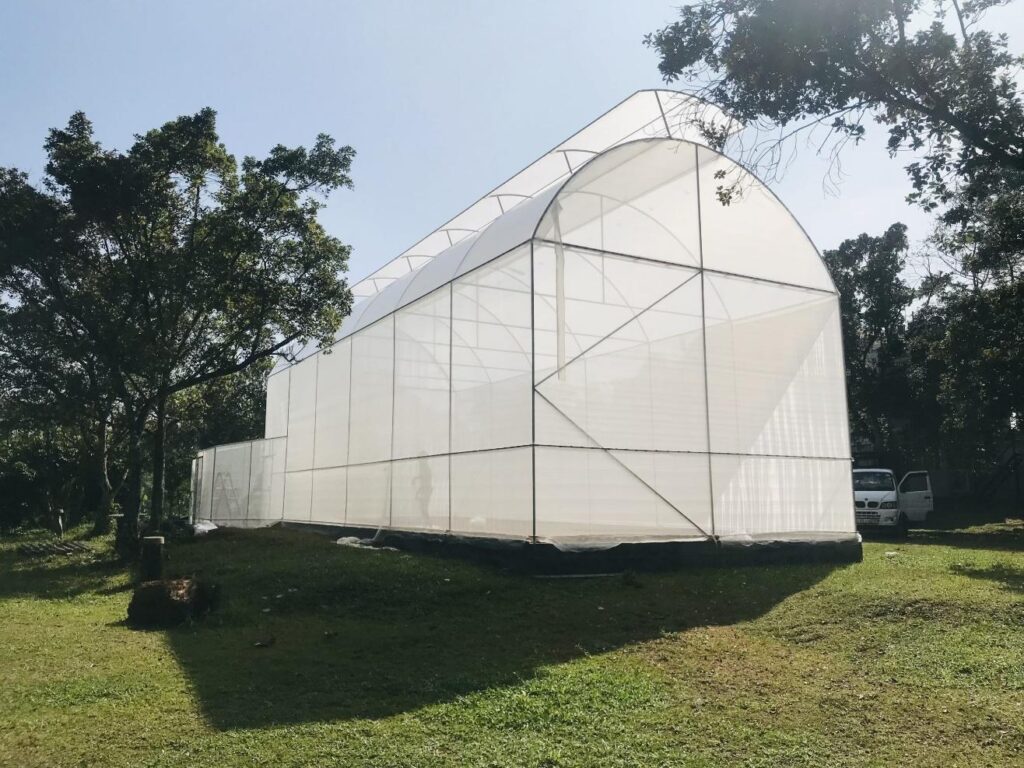Physical Address
23,24,25 & 26, 2nd Floor, Software Technology Park India, Opp: Garware Stadium,MIDC, Chikalthana, Aurangabad, Maharashtra – 431001 India
Physical Address
23,24,25 & 26, 2nd Floor, Software Technology Park India, Opp: Garware Stadium,MIDC, Chikalthana, Aurangabad, Maharashtra – 431001 India

Sri Lanka is a tropical country, and it is not uncommon for warm to hot temperatures in Sri Lanka. But in 2023, the drought made the situation a bit harsh. Sri Lankan dry zone farmers are challenged with the highest temperature and less rainfall. Though the monsoon season has started, the damage caused by the later dry season has become harder to repair.
Sri Lankan chili cultivation is another agricultural sector that has faced these issues thoroughly.
Dry Zone in Sri Lanka
Approximately 70% of Sri Lankan land belongs to the dry zone, mainly in the northern, north-central, and eastern regions.

This zone is characterized by flat or gently rolling terrain with a few mountain areas. Rivers and lakes in this region are often seasonal and depend on monsoon rains.
The dry zone experiences a pronounced dry season and a distinct wet season. The dry season typically lasts from May to September, with minimal rainfall during these months. The wet season occurs from October to January, bringing most of the annual rainfall to the region. The dry zone receives significantly less rainfall than other parts of Sri Lanka, making it arid or semi-arid.
Agriculture in the dry zone is challenging due to the limited availability of water resources. Farmers in this region often rely on irrigation systems, such as tanks and wells, to cultivate crops like paddy. Drought-resistant crop varieties and water management practices are essential to sustain agriculture in these arid conditions. Facing the above challenges, dry zone farmers support Sri Lankan food production by producing more crops.
Chilli Cultivation in Sri Lanka
Chilli cultivation is an essential agricultural activity in Sri Lanka, and it plays a significant role in the country’s economy and culinary traditions.

Chilli is a tropical and subtropical plant type requiring warm and sunny conditions to thrive. The ideal temperature for chili cultivation is considered 20-25°C. However, the warm and dry weather is perfect for the fruit maturity of chili. Well-drained soil with good organic content is preferred for chili cultivation. Accordingly, the dry zone of Sri Lanka, with its hot and arid climate, is well-suited for chili cultivation.
We here archived all chili cultivation’s climate, geographical, and environmental constituents. Here is another article on chili cultivation.
Dambulla is a famous dry zone in Sri Lanka for cultivating plants such as chili and onion. Though Dambulla belongs to the Matale district, it does not have typical geographical and climate situations in the Matale district.
We discussed with the chili farmers the challenges that they are facing through this time while they are cultivating chili.
Chilli Farming Situation in Dry Zone
To learn about chili cultivation in the Dambulla area, we met commercial-level chili farmers in Galewela. Mr. Anura Bandara is one of the experienced commercial chili cultivators in Moragolla, Galewela.
Farmers in this area are cultivating chili for two significant purposes. One is harvesting the fruit and releasing it to the local market. The other purpose is harvesting chili seeds for planting.
According to Mr. Anura Bandara, chili seed harvesting is more profitable. But the effort and investment for cultivating them is higher.
Usually, if the l farmer harvests chili fruits for the market, they cultivate chili outdoors. But for the seeds, the environmental conditions must be controlled thoroughly so farmers can use greenhouses and such alternatives.
Challenges that Farmers are Struggling while Cultivating Chilli Outdoors

According to Mr. Anura, there are many challenges for the farmers while cultivating chilly outdoors. One of the significant challenges from these is struggling with changing weather patterns.
“Some years, according to the predictions and weather reports, we could do our cultivation with fewer weather pattern changes. But in a few years, the weather pattern changes are hard to predict and unexpected. With this, our cultivation seasons do not fit well. But a few years ago, this situation was not as hard as this. The unexpected disasters were not common like this so we could have a good harvest after one cultivation season.” Mr. Anura Bandara commented. “Especially this year, we had a terrible drought. Most of our cultivations were destroyed. Not only chili but also paddy and many other cultivations were destroyed. By now, there is a little bit of rain in our area. But in the other years, these days we have more rain than this due to monsoons. This year, that also has changed. Rain stopped from Kurunegala, and we are also thoroughly struggling with water deficiency.”
Mr. Anura said further that unexpected drought caused the drying of their cultivation. Some farmers are facing a water supply challenge for their cultivation.
The next major challenge of outdoor chili farming is damage caused by pests. The outdoor cultivations are easy targets to reach for the problems, and they sooner attack the cultivations. Especially at night, they are doing severe damage to the crops.
According to Mr. Anura Bandara, dry weather is influencing the egg-hatching of the pests and increasing their damage to the crop. So, this year, the damage with the problems is also higher than in other years in the Dambulla, Galewela area.

The other challenge for these cultivations is the high-speed spreading of diseases in chili plants in the area. Mr. Anura said that the outdoor chili cultivations are exposed to the atmosphere. So, the microbes that can cause diseases quickly contact these plants and spread them throughout the area. Here also, Mr. Anura said that dry weather influences this as well. High temperatures increase the spreading of diseases in the cultivation.
So, these three significant challenges became more horrific this year, and the damage of chili cultivation was higher than in other years. The farmers in this area are hoping for a better climate next year for their cultivation.
Challenges that Farmers are Struggling while Cultivating Chilli Indoors
Mr. Anura mainly does chili cultivation indoors for harvesting seeds. These seeds have high demand in the market. The farmers are selling these seeds to the agricultural companies in Sri Lanka.
Even the seeds for these cultivations are unique and should be obtained from government-authorized offices.
However, these cultivations are conducted in polytunnels.

Mr. Anura said the polytunnels are targeted, making high temperature and humid conditions inside ideal for chili cultivation.

Plants inside the polytunnels have protection from most of the unexpected weather conditions. They are not in direct contact with external environmental conditions, and the inside situation is at a level that can be controlled.
These plants are not exposed to the atmosphere. So they are not easily affected by the disease spreading from other nearby cultivations.
There is a boundary to protect these from the pests to these polytunnels. However, it does not say polytunnels can 100% preserve plant cultivation from problems. According to Mr. Anura Bandara, if pests reach inside a polytunnel, their effect on the plant is higher than outdoor cultivations. In the outdoors, with high sunlight, pests are only activated in the nighttime, but in the more comfortable conditions, they are started both night and day in polytunnels.
The increase of egg hatching of the pests in warm climates has increased the chance of harming the polytunnel chili cultivations.
With the high temperature this year, Mr. Anura mentioned that the yield from his polytunnel chili cultivation decreased compared to other years.
Polytunnel chili cultivation needs much more initial investment than outdoor cultivation, so not all farmers can use this method. In Sri Lanka, most farmers use this method to harvest seeds. In both of these methods, deficiency of water matters. But farmers, however, manage to supply water continuously to their cultivations. Mr. Anura said their effort was successful and could save more than destroying their whole crop.
Also, Mr. Anura Bandara commented that this area’s human-wildlife conflict is increasing. Most of these wild animals do not harm humans but harm many cultivations. The lakes are drained in the forests, and they come to the village for water and food. Luckily, wild animals do not majorly affect chili, but many other cultivations are affected. The farmers do not rely on cultivating one cultivation. Mr. Anura also produces many other vegetables, such as brinjal, ladies’ finger, and manioc. They are thoroughly affected by almost all the above issues and wild animal harm.
The rise in the prices of fertilizers, herbicides, and pesticides also worsens the situation. Even organic fertilizers and other chemicals are costly. So, the cost of the production is high. With the increase in pests and weeds, they need to use more and more expensive chemicals.
With high temperatures, the resilience of weeds and pests has increased. This makes the situation worse. The chemicals should be more powerful than before, and it costs more. Here, it is archived for the effect of global warming on pest control.
So, people in the Moragolla, Galewela area are now attached to cultivating chili, capsicum, and mainly tobacco. Though these cultivations also suffer from disease, pests, and climate, they cannot combat wild animals.
With these struggles for chili cultivation, the price range has been raised for them with high demand in the markets.
The farmers are still very enthusiastic about cultivating chili as they have losses in their yields; they get enough value for the remaining work saved from the disasters. The failures of the product do not affect the losses of the selling price.
Conclusion
Farmers cultivate chili for different purposes according to the sources that they own. Some harvest chili seeds, some harvest green chili, and some harvest red chilies. Anyway, all of them have high demand, no matter what.

Chilli cultivation is a good, profitable agricultural practice in dry zones. But with time, this cultivation also has to struggle with many challenges. However, the higher demand in the market for chilies will prevent farmers from stopping cultivating them even with the decreasing yield.
The consumers are the pressuring part of society with the above struggles. The farmers get the value for their effort, and after farmers and other intermediary parties, the whole burden will be transferred to the consumers.
-With inputs from Mihiri Saparamadhu-